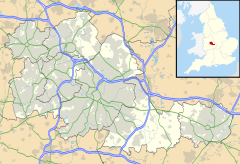Ladywood
| Ladywood | |
|---|---|
| Ladywood shown within the West Midlands | |
| Population | (2011 Ward) |
| OS grid reference | SP055865 |
| Metropolitan borough | |
| Metropolitan county | |
| Region | |
| Country | England |
| Sovereign state | United Kingdom |
| Post town | BIRMINGHAM |
| Postcode district | B16 |
| Dialling code | 0121 |
| Police | West Midlands |
| Fire | West Midlands |
| Ambulance | West Midlands |
| EU Parliament | West Midlands |
| UK Parliament | |
Ladywood is an inner-city district next to central Birmingham. In June 2004, Birmingham City Council conducted a city-wide "Ward Boundary Revision" to round-up the thirty-nine Birmingham wards to forty. As a result of this, Ladywood Ward's boundaries were expanded to include the neighbouring areas of Hockley, Lee Bank and Birmingham city centre.
At the time of the 2001 Population Census, 23,789 people were living in the LadywoodLadywood Ward. The population density was 3,330 people per km2 living within its 7.1 km² boundary, compared with 3,649 people per km2 for Birmingham. Nearly half of the population of Ladywood (49%) consisted of ethnic minorities compared with 29.6% for Birmingham in general. The largest ethnic minority groups were Afro-Caribbean at 13.18%, Indian at 11.65%, Pakistani at 10.64% and Mixed Race at 5.52%.
The Ladywood ward combines areas of varying land-use, such that no generalisation is possible. There is the city centre (the economically valuable Central business district), the affluent Jewellery Quarter, and Broad Street areas which have become fashionable for "luxury flat" living, the Lee Bank area (now known as Park Central) which has been fully redeveloped, and there is the remainder of the ward, which is Ladywood itself ( known as "remainder Ladywood") which is relatively economically impoverished.
Most of "remainainder Ladywood" was redeveloped during the 1960s, with decaying terraced slums being cleared to make way for new low-rise housing and high-rise flats. Although the newer homes were an improvement on their predecessors in terms of quality and sanitation, social problems became prevalent in much of the local area including car crime, drug dealing, anti-social behaviour and many of the other problems commonly associated with inner city areas across England.
...
Wikipedia

